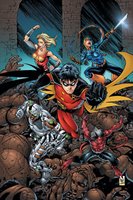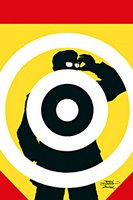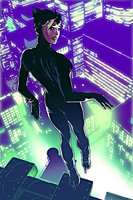 "The Good Fight Part One: Cain & Abel"
"The Good Fight Part One: Cain & Abel"
Story by Judd Winick, art by Matthew Clark and Art Thibert.
I approached this one with, if not quite a vested interest, then at least a nostalgic curiosity. Batman and the Outsiders was my favorite comic when I was 11, and the first title that I collected. (I think I had every issue of the original run; I probably still do.) Looking back, it's hard to say what I liked about it so much, except that I got in on the ground floor, so there wasn't a lot of backstory to go over my 11-year-old head. (I hated feeling like I was missing something.) But I still have a certain sentimental attachment to those Mike W. Barr/Jim Aparo issues (an attachment that would surely crumble to dust were I to reread one), and every month, when I see an issue of the current Outsiders series on the racks, part of me thinks I'm supposed to buy it, and then starts worrying about all the issues I've missed since 1986.
Nothing to worry about, it turns out.
The first three pages of this comic consist of a backgrounder on the child soldiers forced into Mali's civil war; the rest follows Thunder, a superhero, who has somehow infiltrated the highest echelons of Mali's government as part of the Outsiders' effort to stop the practice. Winick apparently thinks he's writing Green Lantern/Green Arrow, the 1970s series that brought superheroes face to face with "issues" like poverty, racism, and overpopulation for the first time. The problem with this approach is obvious after about fifteen seconds of thought: the presence of, say, Superman changes the equation for things like African child soldiers. This fifteen-seconds-of-thought insight was the basis of Watchmen, which after Green Lantern/Green Arrow was pretty much inevitable. After Watchmen, there are two paths a writer can take: he can follow the implications of "superheroes existing in the world," the way Watchmen and Miracleman and The Authority do, or he can decide that his superheroes live in a world that, while superficially similar to our own, does not contain things like African child soldiers, the way almost every other superhero comic does. But having Metamorpho and Captain Boomerang jump out from behind a rock to try to prevent the massacre of an African village by 12-year-olds with machine guns ... no. It won't fly.
The bigger problem with this is factual: according to Human Rights Watch, Mali doesn't employ children as soldiers and indeed leads efforts to eradicate the practice elsewhere. Apparently, when you want to throw a little African-child-soldier action into your lousy superhero comic, one African country is pretty much the same as another.
There are other, less geopolitically idiotic, problems with this issue, but I'm only going to mention one: the absurd last page, in which the team spontaneously organizes into a pinup arrangement (Metamorpho actually flexes a muscle) while Nightwing informs us of the Outsiders' new status quo with this sparkling little gem of dialogue: "Hell, by tomorrow morning it'll be a miracle if the whole world doesn't know that you're all not actually dead." Well put!




